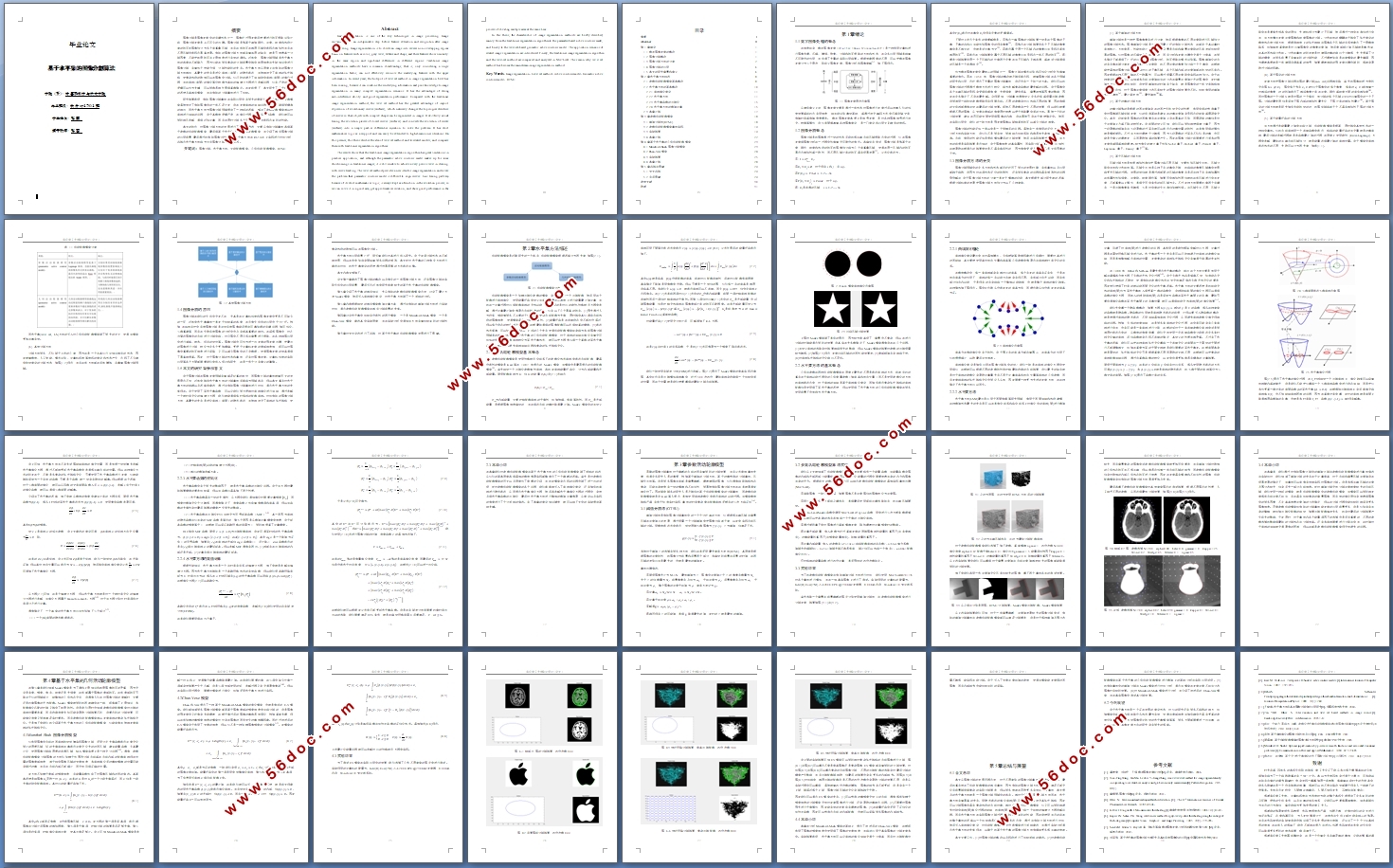基于水平集的图像分割算法(任务书,开题报告,外文翻译,论文16000字)
摘要
图像分割是图像处理中的关键技术之一,图像经过预处理后想要进行特征提取识别之前,图像分割处理是必不可少的步骤。图像分割是指基于诸如颜色、灰度、纹理和形状之类的特征将图像划分为多个非重叠区域,并且这些特征在相同区域中表现出相似性并且在不同区域中表现出显著差异。传统的图像分割方法都有着共同的缺点,就是只考虑单一分割因素,不能把底层特征与上层信息进行有效的调和。近年来,图像分割领域里水平集方法的热度在不断飙升,因为它能在很多复杂的分割场景中结合底层信息与先验知识来进行图像分割,有着抗干扰能力强,分割性能好的优点。水平集方法从原理上与传统的图像分割方法相比,其最大的优点是进化曲线(曲面)的隐式表达,自然地改变了曲线的拓扑结构,使复杂形状的物体可以在图像中分割。它巧妙的避开了追踪闭合曲线(曲面)的演化过程,并将曲线(曲面)的演化等价转换为单纯的偏微分方程进行求解问题,它有严密的数学逻辑可以作为支撑,可以很容易地扩展到高维情况。在此前提下,本文研究了水平集方法的思想及其相关模型,并与传统的分割算法进行了比较。
研究结果表明,传统图像分割算法在实际应用中有很大的局限性,而参数活动轮廓模型虽然弥补了传统图像中的一些不足之处,但在处理曲线的追踪问题还是无法做到很精准的地步,而水平集方法为图像分割领域提供了一种新的思路,解决了参数轮廓模型难以对曲线进行追踪的问题,由于其数学逻辑严密,在演化过程中始终保持为函数,我们就可以很好地区求解,得到近似计算,而且在同时分割多个区域的过程中表现出良好的性能。
本文的特色,对图像分割方法的发展进行了简要的阐述,主要从传统分割算法再到基于参数的活动轮廓模型,最后到基于水平集的几何活动轮廓模型,并介绍了相关图像分割的应用场景,最后通过将传统图像分割算法与水平集方法在MATLAB上实现进行对比分析,总结出水平集方法成为主流图像分割方法的原因。
关键词:图像分割;水平集方法;主动轮廓模型;几何活动轮廓模型;OTSU
Abstract
Image segmentation is one of the key technologies in image processing. Image segmentation is an indispensable step before feature extraction and recognition after image preprocessing. Image segmentation is to divide an image into several non-overlapping regions based on features such as color, gray level, texture and shape, and these features show similarity in the same region and significant differences in different regions. Traditional image segmentation methods have a common disadvantage, that is, only considering a single segmentation factor, can not effectively reconcile the underlying features with the upper information. In recent years, the hotspot of level set method in image segmentation field has been soaring, because it can combine the underlying information and prior knowledge to image segmentation in many complex segmentation scenarios. It has the advantages of strong anti-interference ability and good segmentation performance. Compared with the traditional image segmentation method, the level set method has the greatest advantage of implicit expression of evolutionary curves (surfaces), which naturally changes the topological structure of curves so that objects with complex shapes can be segmented in images. It skillfully avoids tracing the evolution process of closed curves (surfaces) and converts the evolution of curves (surfaces) into a simple partial differential equation to solve the problem. It has strict mathematical logic as a support and can easily be extended to high-dimensional situations. On this premise, this thesis studies the idea of level set method and its related models, and compares them with traditional segmentation algorithms.
The results show that the traditional image segmentation algorithm has great limitations in practical application, and although the parametric active contour model makes up for some shortcomings in traditional images, it is still unable to achieve a very precise level in dealing with curve tracking. The level set method provides a new idea for image segmentation and solves the problem that parametric contour model is difficult to align curves. Line tracing problem, because of its strict mathematical logic, is always kept as a function in the evolution process, so we can solve it in a good area, get approximate calculation, and show good performance in the process of dividing multiple areas at the same time.
In this thesis, the characteristics of image segmentation methods are briefly described, mainly from the traditional segmentation algorithm to the parameter-based active contour model, and finally to the level-set-based geometric active contour model. The application scenarios of related image segmentation are introduced. Finally, the traditional image segmentation algorithm and the level-set method are compared and analyzed in MATLAB. The reason why level set method has become the mainstream image segmentation method.
Key Words:Image segmentation;Level set method;Active contour model;Geometric active contour model;OTSU

目录
摘要 I
Abstract II
第1章绪论 1
1.1数字图像处理的概念 1
1.2图像分割概念 1
1.3图像分割方法的分类 2
1.4图像分割的应用 6
1.5本文的研究背景和意义 6
第2章水平集方法综述 8
2.1参数活动轮廓模型基本概念 8
2.2水平集方法的基本概念 10
2.2.1曲线演化理论 11
2.2.2水平集方法 11
2.2.3水平集函数的初始化 15
2.2.4水平集方法的数值计算 15
2.3本章小结 17
第3章参数活动轮廓模型 18
3.1阈值分割法(OTSU) 18
3.2参数活动轮廓模型算法实现 19
3.3实验结果 19
3.4本章小结 22
第4章基于水平集的几何活动轮廓模型 23
4.1 Mumford-Shah图像分割模型 23
4.2 Chan-Vese模型 24
4.3实验结果 25
4.4本章小结 28
第5章总结与展望 29
5.1全文总结 29
5.2今后展望 29
参考文献 30
致谢 31
|



